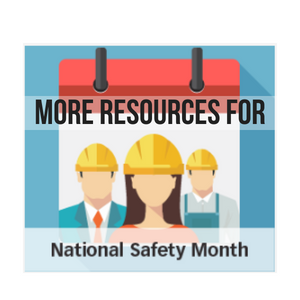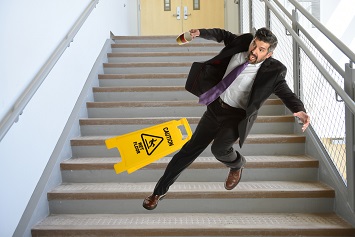As we get ready to enter week 3 of the National Safety Council’s (NSC) annual National Safety Month, the focus is on falls—and with good reason. Violations of the Occupational Safety and Health Administration’s (OSHA) general requirements for fall protection topped the list of most frequently cited standards for fiscal year 2017, and falls remain one of the most common causes of serious work-related injuries and deaths in both general industry and construction.
 Though most people assume that falls are primarily a concern for those working at elevated heights, there are plenty of slip, trip, and fall hazards in every work setting. Let’s review some common fall hazards and what you can do to prevent them.
Though most people assume that falls are primarily a concern for those working at elevated heights, there are plenty of slip, trip, and fall hazards in every work setting. Let’s review some common fall hazards and what you can do to prevent them.
Dangerous Surface Conditions
One of the most frequent causes of slips, trips, and falls is the presence of poor walking-working surface conditions, such as slippery, uneven, or wet floors; dimly lit walkways; or areas covered with debris. To avoid these hazards, make sure to properly maintain work areas by:
- Cleaning up any leaks, spills, or debris from floors, stairs, entranceways, and loading docks immediately;
- Keeping walkways, aisles, and stairs free of tools, materials, and other hazards;
- Placing trash in the proper containers;
- Removing cords, power cables, and air hoses from walkways;
- Providing adequate lighting for all walkways;
- Using slip-resistant floor treatments and “wet floor” signage; and
- Repairing or reporting hazards, such as broken planks and/or missing tiles.
You can also prevent falls caused by poor walking-working surface conditions by conducting regular walk-through inspections of work areas to ensure they are risk-free, encouraging employees to wear slip-resistant shoes, designing all entrances and walkways to accommodate foot traffic, and preventing employees from taking shortcuts through unsafe areas.

Stairs and Ladders
Another common fall hazard in the workplace is the improper use of stairs and ladders. When using stairs, be sure to walk—not run—and use the railings when going up or down. Make sure materials or tools are not left on the stairs, and report any damaged treads, railings, or lighting.
When using ladders, check that all cleats, rungs, and steps are in good condition, and set up the ladder correctly on a stable, level surface. Face the ladder and hold onto it with both hands while climbing. Finally, make sure you choose a ladder that is the appropriate height for the task, and never use boxes or chairs to reach high places.
Emerging Fall Risks
As part of its National Safety Month fall awareness campaign, the NSC is also drawing attention to another increasingly common slip, trip, and fall risk—distracted walking. Due to nearly ubiquitous cell phone use among workers, distracted walking has led to more than 10,000 serious injuries over the past decade. In order to minimize the likelihood of falls caused by cell phone use and distracted walking, the NSC recommends that workers avoid looking at or using cell phones while walking. If you need to use your phone, find a safe area to stop walking and remain until you are finished.
Helpful Tools
You may want to review the following Safety.BLR.com® tools for more helpful information regarding fall protection:
- “Don’t Fall Down on the Job” poster
- Toolbox Talk: Fall Protection: Preventing Falls in General Industry
- Toolbox Talk: Spills, Falls, and Cuts Hazards in Food Service
Not a Safety.BLR.com subscriber? Visit the site today and take advantage of all that it has to offer!
